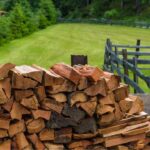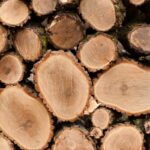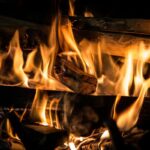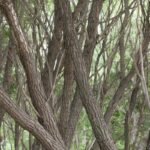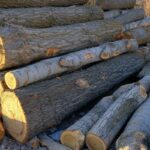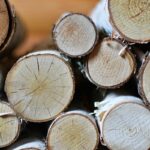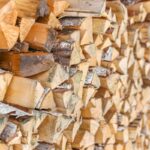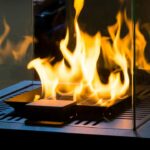Worldwide, there are over 100 species of maple trees. This can make it challenging to figure out whether maple is good for burning as many of these species will burn differently to one another.

All in all, maple is a popular hardwood that is often considered a good choice for firewood. This is due to its high heat output, low smoke amount, and pleasant aroma.
Maple is also readily available, so you should not have an issue finding it for firewood on a regular basis. Maple burns well and spits well, with many properties that make it a user-friendly firewood.
Want to find out more about maple wood? You’re in the right place. Today, we are going to explore the characteristics of maple, the benefits of using this wood for burning, some potential disadvantages of it, how to store it properly, and much more.
So, let’s get started and learn more about maple as a potential firewood.
Characteristics Of Maple Wood
What Is Maple?
Maple wood comes from maple trees. These are hardwood and are known for their beautiful colors during fall, and they are used in the process of making maple syrup.
Maple belongs to the genus Acer and is native to North America, but it can be found in other regions of the world today.
Maple trees are known for their distinctive leaves, which are shaped like a hand with five lobes, and their sap, which can be used to make that iconic maple syrup.
There are over 100 species of maple worldwide, including sugar maple, red maple, silver maple, and black maple.
Amongst the many species, characteristics are shared between them all, helping them stand out from many other tree types.
Physical And Chemical Characteristics
Here are the common characteristics shared by maple trees and wood around the world:
- Leaves – A Maple leaf’s shape is similar to that of a hand. The species will typically determine whether it has three or five fingers, but all species of maple trees drop their leaves during winter.
- Bark – The bark of a young maple tree is generally smooth with a greyish-brown tone. Mature maple trees tend to have a rougher bark that is brownish. This bark usually splits into furrows and ridges, too.
- Fruit – Every kind of maple tree produces fruits. These are essentially seed pods known as “samara.” These pods are typically around one to two inches in length and contain one or two seeds.
- Size – Most maple trees tend to grow to around 50 to 75 feet in height when growing in the wild. But, when grown in residential landscapes, they are closer to 20 to 30 feet high.
Maple wood’s chemical composition can vary depending on the species, but it typically contains a mixture of cellulose, hemicellulose, and lignin. It also has a low moisture content, which makes it easier to ignite and burn efficiently.
Additionally, maple has a relatively low amount of resin and sap, which reduces the buildup of creosote in chimneys and flues.
Maple wood also has a pleasant aroma when burned, which can add to the ambiance of a fire and be a welcome addition to your home’s log fire.
How Maples Compares To Other Woods
When we compare maple to other types of wood, we find that it has several advantages when used as firewood.
Firstly, its high density and low moisture content helps it burn more efficiently and at a higher temperature than softer woods, such as spruce or pine.
Moreover, maple does not produce as much smoke or creosote buildup. In turn, this can reduce the risk of chimney fires when it is burned.
Compared to some types of wood, though, maple can be more challenging to split and tends to require a greater effort to cut, especially when compared to harder woods like hickory or oak.
Benefits Of Using Maple Wood
Efficiency In Producing Heat
Maple can produce anything from 18.1 to 26.8 million BTUs (British Thermal Units) per cord, depending on the species. In general, a cord of maple equates to the heat sources shown below:
- 246 gallons of propane
- 21,649 cubic feet of natural gas
- 6,580 kilowatt hours of electricity
- 162 gallons of heating oil
One cord of firewood equates to 138 cubic feet of wood. The majority of firewood is cut into lengths of 16 inches before being stacked into piles of three rows. These are generally eight feet long and four feet high, resulting in a total of 128 cubic feet.
Clean Burning Properties
When burned, maple firewood typically produces minimal smoke and sparks, and with proper seasoning, it can provide long-lasting and steady burns. Its clean-burning properties make it a popular choice for heating and cooking.
Low Moisture Content
Maple is a firewood that should be seasoned for around six months and cut quickly. This is because it has a low moisture content, making it easier to ignite and burn efficiently.
The best moisture content for firewood is generally less than 20%. Wood with a higher moisture content may be able to burn eventually but can be hard to light and keep lit.
Pleasant Aroma
There’s no doubt that maple has a very pleasant aroma. Its scent is not too overwhelming, with many comparing it to maple syrup.
When burned, maple can be described as having a sweet and slightly spicy aroma, with hints of vanilla and caramel. This can add a beautiful ambience to your home.
Potential Drawbacks Of Using Maple As Firewood
Difficulty In Splitting
Matured maple typically splits into furrows and ridges. Although easier to split than some hardwoods, maple wood is generally a dense and heavy hardwood. Therefore, it can be more difficult to split than softer woods.
However, with the right tools and technique, it can still be split effectively for use as firewood.
Relatively High Cost Compared To Other Firewood Types
One drawback of using maple as a regular source of firewood is its higher price tag compared to some other types of wood. That being said, the cost of maple wood can vary depending on its availability, location, and demand.
In certain regions, it is certainly more expensive than other types of firewood, but in others, it can be more affordable.
Hardwoods like maple tend to be more expensive than softwoods, such as pine or spruce, but they also tend to burn hotter and longer, making them a good value in the long run.
Availability And Sourcing Challenges
It can be more challenging to source maple wood in some regions compared to others. This is typically due to a limited supply or high demand in the area.
Because maple is sometimes harvested less frequently than other types of hardwood, such as oak, it can be harder to find.
On top of this, transportation and delivery costs can quickly add up with the overall expense of the wood being higher than other types of firewood.
How To Properly Store And Use Maple Firewood
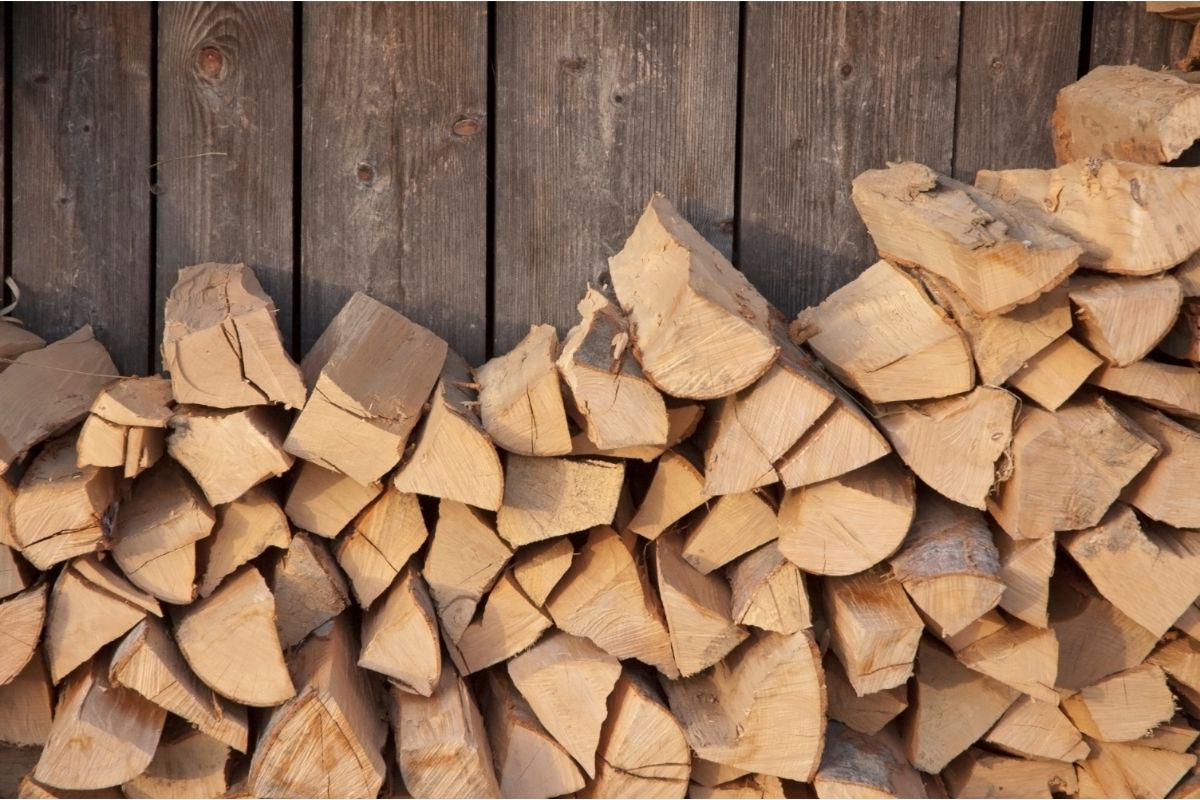
Importance Of Seasoning
By properly seasoning your maple firewood, you can extend its usage and reduce the amount of creosote it produces. Seasoning maple firewood can also reduce its moisture content, making it easier to ignite and then burn more efficiently.
Some freshly cut wood can contain as much as 50% water which can lead to excessive smoke when being burned, poor combustion, and a buildup of creosote in flues and chimneys.
When you allow maple to dry and age for a certain period of time (around six to 12 months), you can reduce the moisture content in it to 20% or even less. This improves its burning properties and reduces the risk of possible chimney fires.
Additionally, proper maple seasoning can also enhance its aroma and even the flavor of foods cooked over maple firewood.
Proper Storage Techniques
It is important that maple firewood is stored off the ground and is protected from the elements.
A storage area with a good airflow or a covered woodshed are good options to store maple wood in as it can avoid mold, moisture, and insect infestations here.
It is recommended that maple wood is stacked loosely, too, with enough space between the logs for air to circulate.
This helps the wood to dry continuously and prevents excessive moisture buildup. Also, try to keep the bark facing upward to prevent moisture from getting in between the logs.
And, inspect the wood frequently for any signs of damage or decay. If one is infested, it could lead to others becoming infested as well.
Best Practices For Using Maple Firewood
Here are some common practices you should follow when using maple firewood:
- Only ever used properly seasoned maple firewood to prevent excessive smoke and creosote buildup in chimneys.
- When starting a fire, use small kindling and add larger pieces of kindling afterwards to maintain a steady flame.
- Do not leave the fire unattended. Keep a fire extinguisher or a water source close by in case of an emergency.
- Do not burn maple that has been painted, stained, or treated with chemicals, as this can release harmful toxins into the air.
- Clear out the ashes from the fireplace frequently to prevent a buildup and maintain proper airflow.
- Always avoid overloading the fireplace with too much maple wood. If you do so, it may overheat and increase the risk of a chimney fire.
Comparison With Other Types Of Firewood
Pros And Cons Of Other Popular Firewood Types
Oak
Pros:
- Burns hot and long
- Produces minimal smoke and sparks
Cons:
- It can be difficult to split
- Takes longer to season
Ash
Pros:
- Burns hot and produces a minimal amount of smoke
- Easy to split
Cons:
- It can be difficult to source in some regions
Pine
Pros:
- Burns quickly
- It can be easy to find
- Good for kindling
Cons:
- Produces a lot of smoke and sparks
How Maple Stacks Up Against Other Popular Types Of Firewood
Overall, maple tends to stack up well against other popular types of firewood. Whilst it does hold some advantages, there are some potential drawbacks, too.
Compared to some hardwoods like oak, maple burns cleaner with little smoke and only a few sparks. Also Maple is also relatively easy to split, making it a good option for those who have little experience when cutting wood.
Maple is widely available in many regions and often not as expensive as other hardwoods like beech or cherry.
Regarding the drawbacks of maple, one is that it has a higher moisture content than some other hardwoods, meaning it can take longer to season and will not burn as hot or for as long.
Additionally, some find that maple’s aroma is not as distinctive as other hardwoods like hickory, but this tends to come down to personal preference.
Maple is a versatile and reliable form of firewood that works well in many heating and cooking situations, so it stands up well against many other types of firewood.
Conclusion
You have been wondering is maple a good firewood and most likely can you burn maple in a fireplace.
There are many benefits to using maple as a form of firewood. It burns clean with little smoke, has few sparks, and is relatively easy to split. Maple is also widely available in many regions and often less expensive than other hardwoods.
On the other hand, there are some drawbacks to using maple firewood. It tends to have a higher moisture content than some other hardwoods, so it may take longer to season and not burn as hot or as long as some fully seasoned wood.
And, it may not be as readily available in some regions compared to other types of popular firewood.
All in all, maple is considered a good choice for firewood. Always ensure you buy it from a reputable supplier to ensure it has been properly seasoned and is free from pests or disease.
Thanks for reading.
- How To Open Chimney Flue - July 20, 2023
- Do Electric Fireplaces Use A Lot Of Electricity? - July 20, 2023
- How To Keep A Fire Going - July 20, 2023

